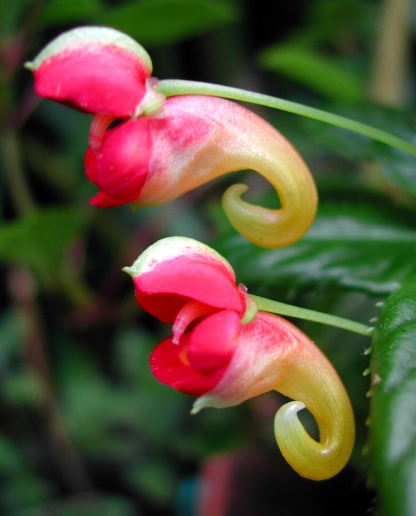| Home |
Strange Wonderful Things Rare and exotic plants |
 |
|---|
Kilimanjaro Impatiens
Impatiens kilimanjari
Getting started -- Impatiens kilimanjari likes moist, well-draining soil that's high in organic matter. Most high quality potting soils should work.
Fill small containers to within 1/2" of the top with screened soil. Water it so it is uniformly moist, but not soggy. Place a seed on top of each pot, and sprinkle a thin layer of soil over it - just enough to cover the seeds. Spray the top soil with a spray bottle. Ensure that the surface soil doesn't dry out. A propagation dome works well for this. The seeds need some light to germinate, such as a fluorescent bulb held a few inches away. The ideal temperature for germination is between 55 and 70 degrees.
I recommend using rain water or bottled spring water until your plants are well-established. You may then use tap water, as long as it's not filtered through a water-softening filter, like Brita or Pur. These add sodium to the water, which may harm the plant.
The seeds should start germinating in 3-5 weeks, but allow up to 10 weeks for any slow ones to sprout.
Climate -- The Kilimanjaro Impatiens prefers temperatures between about 50 and 75. It can tolerate dips into the 40s but should be protected from all frost. The plant has been known to lag in warmer weather. If you're in a warm area, you may wish to grow it indoors. It prefers some humidity - over 30-40% is recommended.
Light -- This Impatiens normally grows on the jungle floor, where the sun is filtered through a lot of trees. It does best with tree-filtered sun or the equivalent. I've grown the plant 8" away from a fluorescent bulb, which gives you an idea of how much light it needs.
Fertilizing -- Impatiens kilimanjari likes average amounts of fertilizer. Feed about every 3-4 weeks during periods of active growth using a complete fertilizer that has micronutrients Don't try to force more growth with excessive fertilizer -- follow the directions closely. It's normal for the older, lower leaves to occasionally turn yellow and drop, but if it's excessive, it may need more fertilizer, particularly nitrogen.
Pruning -- It shouldn't be necessary to prune your plant, although you can cut back leggy branches to one or two "nubs" and the plant will get bushier. Try not to remove more than 10-15% of the branches in a week. You can stake your plant upright if you wish, or let it flop over the side of the pot.
Pests to watch for -- Scale (little brown disks on the stem - very hard to see!), aphids, spider mites (tiny "dots" under the leaves), mealybugs (white - easy to spot). Outdoors, snails/slugs.
If you have any questions, feel free to email me.
Jeff
Strange Wonderful Things
| Home |
Strange Wonderful Things Rare and exotic plants |
|
|---|---|---|
| Entire site Copyright 2003-2025 by Strange Wonderful Things, except as noted | ||

